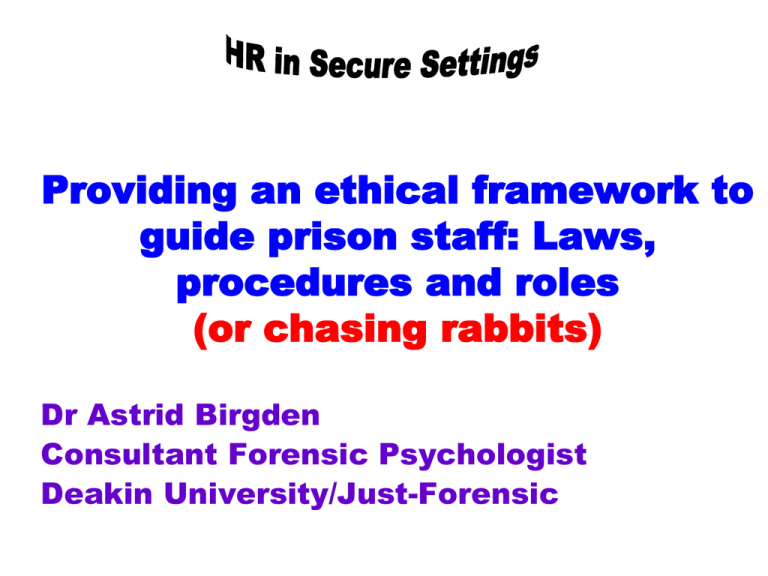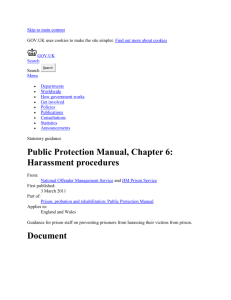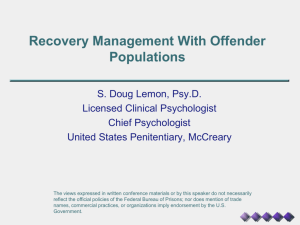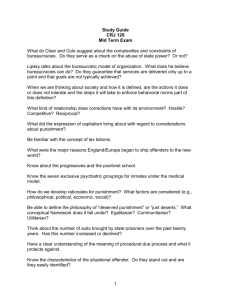Providing an ethical framework to guide prison staff: Laws, procedures and roles
advertisement

Providing an ethical framework to guide prison staff: Laws, procedures and roles (or chasing rabbits) Dr Astrid Birgden Consultant Forensic Psychologist Deakin University/Just-Forensic UN Convention against Torture and Other Cruel, Inhuman or Degrading Treatment or Punishment (1987) Torture during interrogation is a human rights violation. American Ψ Association Presidential Task Force on Psychological Ethics and National Security (PENS) 2005 OK for Ψ to consult or advise (but not assist) in interrogations because: 1. Ψ “have a long-standing tradition of doing in other law enforcement contexts” (p. 1). 2. Ψ are “in a unique position to ensure that these processes are safe and ethical for all participants” (p. 1). * But, torture in interrogation was outside international human rights law. AΨA Policy Position The American Ψ Association: • Weighed “organisational consultant” role against “treatment provider” role. • Weighed “community protection” policy against “do no harm” ethic principles. That is, detainee rights were trumped by community protection and so Ψ treated detainees as objects or a means to an ends. Unethical Ψ Practice Ethical Warning “…unquestioned support for ideological banners of “national security,” or other high-sounding phrases (i.e., community protection/good order & security). In other nations, at other times, that same ideology was used to justify torture and suppression of human rights. Ψ seek objective truth behind slogans and euphemisms, and live by empirical evidence to guide their professional functions” (Zimbardo, 2007, p. 73) What do various UN declarations have in common? The right to self-determination or autonomy and well-being. Prison staff are ethically obliged to support offender autonomy and well-being. So, how do prison staff balance offender rights and community rights? A values-based question Therapeutic jurisprudence: 3 areas of legal enquiry The impact of the law can be therapeutic or anti-therapeutic. Legal rules, procedures and roles have an impact on wellbeing. Legal actors should harness the law to be therapeutic and increase offender well-being. (Wexler, Winick) Ethical Framework for Closed Environments Evidence Ethics 1. Does it work? 2. Is it the right thing to do? Offender as…. Rights-Violator and Rights-Holder What are “offender rights”? (Ward & Birgden, 2007) 1. Legal Right Prescribed by particular laws (i.e. domestic & international laws) 2. Social Right Guaranteed by a social institution (e.g. a prison) 3. Moral Right Based on a moral theory or principle….. (Ward & Birgden, 2007) POLICIES OBJECTS Personal Security Personal Freedom v Autonomy Social Recognition Well-Being Material Subsistence e Equality 2 examples of (organic/soft criteria) culture change strategies Aim: Motivation + Capacity Offender The Will The Way Aim: Motivation + Capacity Offender The Will The Way Staff Example 1: Macro Reducing Reoffending Framework (Corrections Victoria) (Birgden & McLachlan, 2002) Corrections Victoria Long-Term Management Strategy Reduce Demand (N=600 beds) Strengthen CCS Community Retention Home detention Bail advocacy Court support Reduce Reoffending (10% prisons, 15% CCS) Manage Prison Bed Demand Offending behaviour programs Pre and post release support New prisons Meet Demand Improve Prisons Minor works Permanent beds Relocatable cellular accommodation Stages of Change Model Culture Change Strategy cont Precontemplation (Birgden, 2002) Contemplation Preparation Action Values & Attitudes Skills Set the scene for rehabilitation Motivational Interactions Attitude Change + Behaviour Change Maintenance Coaching & Mentoring Case Managers New Recruits = Culture Change A cognitive-behavioural approach to culture change Example 2: Micro Compulsory Drug Treatment Correctional Centre (Corrective Services NSW) (Birgden, 2008, Birgden & Grant, 2010) Compulsory Drug Treatment Correctional Centre Act (2004) 4 Objectives 1. Treat drug dependency, eliminate drug use while in the program, and reduce likelihood of relapse on release. 2. Prevent and reduce crime in relation to drug dependency. 3. Promote reintegration into the community. 4. Provide a comprehensive program of compulsory treatment & rehabilitation under judicial supervision. Healthy functioning Being safe Family & social supports Meaningful work & education Leisure activities Choices Intimate r’ships Competence & mastery In changing organisational culture, senior managers need to respond every time staff digress from the agreed ethics & values of the program. I call this “chasing rabbits down holes”, and, as one of my staff saidyou may even need to get right in NSW BOCSAR EVALUATION (July 2010, N=95) • • • • • 4% in Stage 1 (secure) and 0% in Stage 2 (semi-open) felt that they would prefer mainstream gaol. 100% in Stage 3 (community) said Program had changed their life- drug-free + improved problem-solving skills/self-awareness/ decision-making + sorting out finances/ housing/social supports (N = 13). Improved scores on mental/physical health. Low perceived coercion scores and high therapeutic alliance scores. 84% perceived their admission as voluntary! (Dekker, O’Brien & Smith, 2010) Correctional Services should be… A human service system Not a paramilitary organisation! Ethical Practice Don’t treat offenders as a means to an end for “community protection”. Do support offender autonomy and well-being to meet needs (for the offender) and manage risk (for the community). The best argument for observing human rights standards is not merely that they are required by international or domestic law but that they actually work better than any known alternative- for offenders, for correctional staff, and for society at large. Compliance with human rights obligations increases, though it does not guarantee, the odds of releasing a more responsible citizen. In essence, a prison environment respectful of human rights is conducive to positive change, whereas an environment of abuse, disrespect, and discrimination has the opposite effect: Treating prisoners with humanity actually enhances public safety. Moreover, through respecting the human rights of prisoners, society conveys a strong message that everyone, regardless of their circumstance, race, social status, gender, religion, and so on, is to be treated with inherent respect and dignity (Zinger, 2006, p. 127). Birgden, A. (2004). Therapeutic jurisprudence and responsivity: Finding the will and the way in offender rehabilitation. Crime, Psychology & Law, 10(3), 283-296. Ward, T., & Birgden, A. (2007). Human rights and clinical correctional practice. Aggression and Violent Behaviour, 12(6), 628-643. Birgden, A. (2008a). A compulsory drug treatment program for offenders in Australia: Therapeutic jurisprudence implications. Thomas Jefferson Law Review, 30, 367-389. Reprinted:www.bfcsa.nsw.gov.au/__ data/assets/pdf_file/0007/196423/A_compulsory_drug_treat ment_program.pdf Birgden, A., & Grant, L. (2010). Establishing a compulsory drug treatment prison: Therapeutic policy, principles, and practices in addressing offender rights and rehabilitation. International Journal of Psychiatry and Law, 33, 341-349 astrid99@hotmail.com




